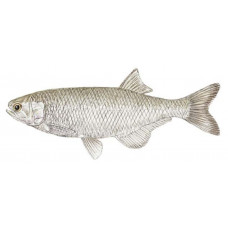Latin name
Hiodon alosoides
Other names
Winnipeg goldeye, western goldeye, shad mooneye, toothed herring, yellow herring; French: la queche, laquaiche aux yeux d’or.
Identification
The goldeye is a small fish with a compressed body that is deep in proportion to its length and covered with large, loose scales. It is dark blue or blue-green on the back, silvery on the sides, and tapers to white on the belly. It has a small head and a short, bluntly rounded snout with a small terminal mouth containing many sharp teeth on the jaw and tongue. The color of its eyes and the position of its anal fin distinguish it from the Moonfisher. The iris of the large eyes is golden and reflects light. The dorsal fin of the goldeye begins opposite or behind the anal fin (the goldeye begins in front of the anal fin). The goldeye can be distinguished from the gizzard shad by the absence of the dorsal fin ray protrusion.
Distribution
Endemic to North America, goldeye are found in both Canadian and American waters. They are found from western Ontario to the Mackenzie River at Acklawick in the north, below the Great Lakes south along the Ohio and Mississippi Rivers in the east, and from western Alberta through eastern Montana and Wyoming to Oklahoma in the west. Lake Winnipeg in Manitoba has historically been the largest commercial producer of these fish.
Habitat
Throughout its geographic range, the goldeye is most commonly found in the warm, silty areas of large rivers and the backwaters of shallow lakes connected to them.
Size
Adults average from 10 ounces to just over a pound and rarely exceed 2 pounds in most waters. They can grow to 5 pounds. Manitoba's record holder is a 5.06 pound fish from the Nelson River. They can live to be 14 years old.
Life history and Behavior
In the spring, when water temperatures reach 50° to 56°F, sexually mature goldeye move to river basins or dammed lakes to spawn.
Food and feeding habits
Goldeye feed on a wide variety of organisms, from microscopic plankton to insects and fish. They obtain most of their food at or near the surface and feed primarily on insects, although they may eat minnows and small frogs.
Reproduction
No information
| Classification | |
| Phylum | Chordata |
| Class | Actinopterygii |
| Squad | Hiodontiformes |
| Family | Hiodontidae |
| Genus | Hiodon |
| Species | H. alosoides |
| Features | |
| Conservation status | Least Concern |
| Habitat | Pelagic |
| Life span, years | 14 |
| Maximum body weight, kg | 0.91 |
| Maximum length, cm | 52 |
| Sailing speed, m/s | No information |
| Threat to people | Edible |
| Way of eating | Predator |
Goldeye
Tags: Goldeye

